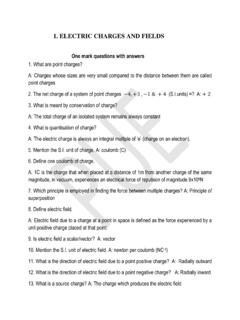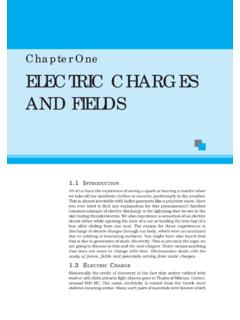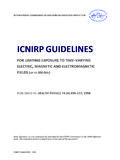Transcription of Some Properties of Birkeland Currents - Electric Cosmos
1 Magnetic Fields of Birkeland Currents D. E. Scott, (EE) Abstract: The fundamental vector calculus definition of a force-free, field -aligned, Birkeland current is expanded in cylindrical coordinates to obtain the partial differential equations (DEs) that yield the magnetic field created by such a current . The resulting equations are put into state-variable form and an Euler, step-wise, approximation incorporating a 4th order Runge-Kutta algorithm is applied. In single-variable form, the DEs are identified as Bessel equations. J0(r) and J1(r) Bessel function solutions confirm the Euler results thus yielding closed form solutions for both the linking (azimuthal) and collinear (axial) components of the force-free field . Results show that both of these magnetic components reverse their directions and vary in magnitude in a way that aids the formation of concentric cylindrical shells of matter as has been observed in Marklund convection.
2 Another result is the finding that magnetic fields extend relatively farther from Birkeland Currents than they would from a straight-line current . They slowly decay as r1 for large r. Introduction The entity that is often called a Birkeland current (and at other times a magnetic ropei or vortex current ) is most descriptively termed a field -aligned current . This concept is usually counter-intuitive for anyone new to the study of electricity in the Cosmos . Even those who are aware of the Properties of Electric and magnetic fields have usually only seen examples where Electric fields and Currents are at right angles (orthogonal) to magnetic fields. Electric motors and generators are prime examples. So is the study of how cyclotrons or mass-spectrometers function. Most, if not all of these phenomena, are based on the Lorentz force that operates on a moving charge within a magnetic field : Bvf (1) The cross product of the moving charge s velocity vector and the magnetic field vector implies that the scalar value of the resulting force is given by sinvBf (2) where is the smallest angle between the vectors v and B.
3 So if that angle becomes zero-valued, the force disappears. Most examples of the interaction of Electric Currents and magnetic fields are presented in an earthbound context wherein the current is confined (and its direction thus controlled by) the shape and placement of the wire (or glass tube in the case of plasma) within which it exists. current will flow wherever the wire is placed. If a motor is wired correctly, the Lorentz force will exist and the motor rotor will spin. This is not necessarily so in space. The conductors there are plasma. These plasmas are not confined and are able to move around and change their shape much more easily than can a wire stapled to a wall or cemented inside a motor housing. Whenever things can move around, they tend to seek a minimum-energy configuration. Water flows downhill. Objects tend to move in submission to applied forces they move in such ways as to minimize the forces they experience.
4 In cosmic plasma, an Electric current and its associated magnetic field are free to take on a minimum-energy configuration. This arrangement is described as a force-free fieldii and has the property that: 0 BB (3) or 0 Bj (4) The equivalence of expressions 3 and 4 is due to one of Maxwell s equations tEjB (5) Therefore, assuming no time varying Electric field is present, the Curl B vector will have the same direction as the current density vector, j. Both expressions (3 and 4) indicate that the magnetic field and the current that causes it will not push or pull on each other when they are exactly aligned.
5 Such an arrangement is termed a field -aligned current . Expression 3 will be obeyed if the curl of B is proportional to B itself (if the current density, j, has the same direction as B). According to expression 3, this will occur if BB (6) where is an arbitrary positive scalar quantity. If we are considering a Birkeland current , the natural coordinate system to use is, of course, cylindrical. (See figure 1.) rrzzxyzxy(r, , z)Figure 1. Cylindrical Coordinates Expression 6 can be expanded in those cylindrical coordinates as follows: zBBrBz 1r1 rBzBzr 1 rBrrBrr11z1 = B = (Br r1 + B 1 + Bz z1) (7) It is reasonable to expect no variation of the magnetic field as a function of the variables or z, therefore the first, second, third, and sixth partial derivatives in expression 7 are assumed to be zero-valued.
6 Thus we have: rBz 1 rBrr1z1 = (B 1 + Bz z1) (8) Separating similar vector components yields rBz= B (9) 2and rBrr1= Bz (10) We are left with two coupled differential equationsiii (9 and 10) in two dependent variables (B , and Bz ). The independent variable in both is r. Euler Method of Solution Because expression 10 is a differential equation (DE) containing a variable coefficient (one that depends on the independent variable) a closed-form solution is not easily obtained. Various methods have been developed for approximating the solution to such Control engineers are occasionally confronted with non-stationary systems ones where the coefficients in the describing differential equations vary with timev.
7 In the system being investigated here, the independent variable is not time, but rather radial distance, r, measured outward from the central z-axis of the Birkeland current stream. The mathematical difficulties are, however, similar. Typically state-variable analysis is used in these cases. A set of state variables for a system consists of the quantities that describe where (and how much) energy is stored in the system. A set of state equations is written with first derivatives of each state variable appearing on the left of the equal signs. No derivatives appear on the right sides of the equations only state variables. In order to describe expressions (9) and (10) in state-variable form, the product rule for derivatives is applied to (10) as follows: zBrrrB (11) zBrBrBr (12) Since energy is stored in magnetic fields, state-variables may be defined as follows.
8 X1 = Bz (13) x2 = B (14) so that, rewriting expressions (9) and (12) in state-variable form yields x1 = x2 (15) and x2 = x1 1/r x2 (16) Using (15) and (16) an Euler (approximate, step-wise) solution of these equations was implemented. Conceptually, each state-variable defines the dimensional distance of a point in space relative to the origin. Derivatives (such as expressions 15 and 16) are thought of as being the velocities of the point along each of those dimensions. If the independent variable (usually time) is quantized in steps of h units, then multiplying each velocity (derivative expression) by h yields the incremental distance the point travels along any given axis during that small time interval.
9 Finally, the value of each state-variable is updated by this incremental distance to get a new value of the variable (position of the point in state-space). A spreadsheet was used to obtain such an approximate solution. In order to improve accuracy, a fourth-order Runge-Kutta predictor-corrector algorithm was incorporated. In iterative solutions such as this, choosing the initial and incremental values for the discretized variables is as much an art as it is a science. 3 Results The results, presented in figure 2, show the total magnetic field strengthvi as being strongest at the minimum radial value (r = 1) and then decreasing with increasing r. Magnetic field Distance (h units)Relative field StrengthAxial Mag FieldAzimuthal Mag FieldTotal Mag Field1/SQRT(r) Figure 2. Magnitude of the axial (Bz), azimuthal (B ), components and the total (vector sum) magnetic field yielded by the Euler-RK algorithm.
10 Combining expressions 15 and 16 yields a single DE in a single dependent variable. 022222 zzzBrdrBdrdrBdr (17) Solution in Closed Form A good friend of the author, Dr. Jeremy Dunning-Davies, recognized this DE as being one with which he was intimately familiar. He wrote saying, I knew that resulting second order differential equation to which I referred rang a bell; it s almost identical to Bessel s equation of order zero it just has the added factor of alpha squared in the non-differential term. So, thanks to Dr. Dunning-Davies, we do indeed have closed-form solutions for the dependent variables in the DE that results from expanding equation (3). The solution to equation 17 is: Bz = J0(r) (18) =.







